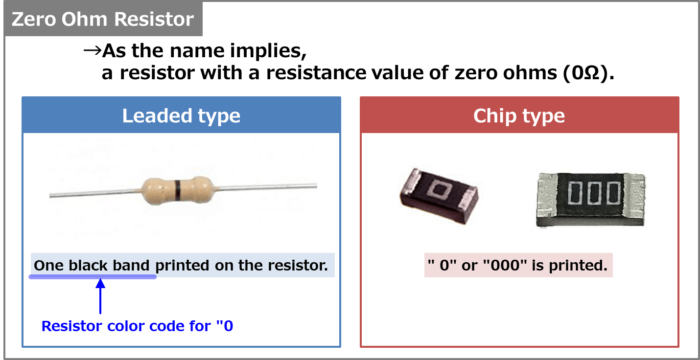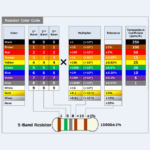When looking at a printed circuit board, a zero-ohm resistor with a resistance value of 0Ω may be mounted.
Have you ever wondered the following questions about zero-ohm resistors?
- Why connect a zero-ohm resistor? What is its use?
- Why not use a jumper wire instead of a zero-ohm resistor?
- What is the difference between a zero-ohm resistor and a jumper wire?
This article summarizes various aspects of zero-ohm resistors to solve these questions.
I will now begin to explain.
What is a Zero-Ohm Resistor?

A zero-ohm resistor is, as the name implies, a resistor with a resistance value of zero ohms (0Ω).
Zero-ohm resistors are also called jumper resistors because they are used like jumper wires connecting wires.
There are two types of zero-ohm resistors: leaded resistors and chip resistors.
- Zero-ohm resistors of leaded resistors
- If a resistor has one black band printed on it, it is a zero-ohm resistor. This black band is the color code of the resistor that represents "0".
- Zero-ohm resistors of chip resistors
- When "0" or "000" is printed on the resistor, it is a zero-ohm resistor.
Related article
The black strip printed on the lead resistor is the color code of the resistor representing "0".
We have summarized the color codes in detail in the following article, which we hope you will find useful. 続きを見る
Resistor Color Code Chart (4-Band, 5-Band)
Rated Power and Rated Current of Zero-ohm Resistors


Zero-ohm resistors have power ratings ranging from 1/10W, 1/8W, and 1/4W to 0.75W and 2W.
In fact, zero-ohm resistors are not exactly 0 Ω, but strictly speaking, have resistance values as minute as 0.001 Ω or 0.003 Ω. The power rating and magnitude of resistance of this zero-ohm resistance is usually listed on the manufacturer's website.
Zero-ohm resistors have an upper limit on the amount of current that can flow, depending on their power rating and resistance value (zero-ohm resistors have a current rating).
As an example, let us consider the case where the "0805-size chip resistor" listed on the manufacturer's website has the following parameters.
- Power Rating PRATED:1/2W
- Resistance R:0.002Ω
Once the power rating PRATED and resistance R are known, the rated current IRATED can be derived. Using the famous equation for current and power (\(P=RI^2\)), the rated current IRATED is the following value
\begin{eqnarray}
I_{RATED}=\sqrt{\displaystyle\frac{P_{RATED}}{R}}=\sqrt{\displaystyle\frac{0.5}{0.002}}=15.81{\mathrm{[A]}}
\end{eqnarray}
From the above equation, we can see that this 0805-size chip resistor can carry a maximum current of 15.81A.
Thus, even a zero-ohm resistor has a minute resistance R and a power rating PRATED, which limits the current that can flow. Therefore, zero-ohm resistors are sometimes used as a substitute for fuses.
So what should we do if we want to flow more than 15.81 A through a zero-ohm resistor? Generally, you can do one of the following two things.
- Use lower-resistance products
- Package size remains the same, but becomes more expensive.
- Increase the package size to increase the rated power
- Larger package size occupies more board space but is less expensive.
Let us now consider the case of a larger package size. Using a "1206-size chip resistor (rated power PRATED: 0.75W, resistance R: 0.002Ω)", the rated current IRATED would be the following value, allowing a current of 15.81A or more to flow.
Supplement
As the package size of a zero-ohm resistor is increased, the resistance value also changes slightly. Usually, the resistance value is in the direction of decreasing.
Difference between a zero-ohm resistor and a jumper wire


Here is a question that some of you probably have about zero-ohm resistors.
What is the difference between a zero-ohm resistor and a jumper wire?
Electrically, a zero-ohm resistor and a jumper wire are the same. However, there are two major reasons why zero-ohm resistors are used
- Easy mounting
- easy circuit modification
Each reason is explained below.
1. Easy mounting
In the case of manual mounting by humans, jumper wires are often used instead of zero-ohm resistors. This is because jumper wires are cheaper than zero-ohm resistors. However, when mounting by machine (automatic insertion machine), the story is different.
Most printed circuit board components are mounted using automatic insertion machines rather than manual mounting by humans.
In the case of zero-ohm resistors, they can be mounted using an automatic insertion machine because their shape can be the same as other resistors.
However, in the case of jumper wires, the shape is different from that of the resistor, making it difficult for the machine to grasp and requiring a separate machine to mount the jumper wire. Alternatively, the jumper wires must be manually mounted by humans. As a result, the work efficiency is lower and the unit price is higher than that of zero-ohm resistors.
2. Easy circuit modification
Zero-ohm resistors have the same shape as other resistors and can be removed more easily than jumper wires.
Therefore, it is easy to change a zero-ohm resistor to a normal resistor or vice versa at a later time.
Considering the possibility of changing to ordinary resistors, the part numbers of zero-ohm resistors are sometimes numbered in the same way as those of ordinary resistors, with Rxx, etc.
What is Zero-Ohm Resistor Used For?
Next, we will discuss the uses of zero-ohm resistors.
Use in jumpers
When you want to cross wires on a printed circuit board, use a zero-ohm resistor for one of the wires and pass the crossed wires under it in a printed pattern.
Use to connect analog GND and digital GND
Generally, analog GND and digital GND are connected at a single point, but when using CAD, it may not be possible to connect them at a single point. Therefore, a zero-ohm resistor may be used to connect analog GND and digital GND.
Use for circuit study
When building a circuit board, you may want to connect or disconnect wires depending on how you use the board. In such cases, if a zero-ohm resistor is mounted, the circuit operation can be changed depending on whether the zero-ohm resistor is mounted or not.
When making products with different specifications
Product specifications differ when products have different functions or are exported to different countries. For example, consider the following Product A and Product B.
- Product A: Connect terminal X to terminal Y
- Product B: Terminal X is not connected to terminal Y
In this case, if there is no other difference between the two products, both Product A and Product B can be made by making the printed circuit boards common, providing a place to connect a zero-ohm resistor between terminals X and Y, and changing whether the zero-ohm resistor is connected or not.
Although there is a subtle increase in component costs due to the connection of a zero-ohm resistor, by standardizing the printed circuit boards, design costs + board production costs + management costs can be reduced. It also makes PCB management easier.
Use in Place of Switches


DIP switches are sometimes used to switch circuits by mounting DIP switches on the board, but because of their large outer shape, there are restrictions on where they can be placed.
Therefore, a zero-ohm resistor may be connected instead of a DIP switch to switch circuits by changing whether the zero-ohm resistor is connected or not.
Summary
This article described the following information about "zero-ohm resistor".
- Zero-ohm resistors include chip and lead resistors.
- Not a perfect 0 ohm, but strictly speaking, it has a tiny resistance value of 0.001 ohm or something like that
- Because of their power rating, there is a limit to the current that can flow through them.
- Difference between a zero-ohm resistor and a jumper wire
- Zero-ohm resistor applications
Thank you for reading.